Approaching Bike Hazards via Crowdsourcing of Volunteered Geographic Information
Abstract
1. Introduction
1.1. Trends in Participatory Mapping
1.2. Cycling Hazards and Their Perception
2. Material and Methods
2.1. Cycling in the City of Freiburg
2.2. Objectives and Research Questions
2.3. Collaborative Research Design
2.4. Analyzing Uncertainties
3. Results
3.1. Reliability of VGI
3.2. Dangerous Hot Spots
- Areas in which the perceived dangers increase with the number of accidents (1a, 2b, 3c).
- 3c:
- one large cluster containing 19 coherent hexagons in the inner city area as well as 3 × 3 coherent hexagons nearby. Furthermore, scattered islands (n = 22) throughout the city area; n = 50.
- 2b:
- homogeneously scattered around the inner city with some small clusters ranging from 2 to 4 hexagons, but mainly islands; n = 48.
- 1a:
- mainly around the outskirts with large areas to the north and southwest of the inner city area; n = 343.
- Areas where the perceived hazards increase but the accidents do not (1a, 2a, 3a).
- 1a:
- see above; n = 343.
- 2a:
- numerous coherent neighbourhoods alongside edges. Few islands but many small clusters ranging from 2 to 11 hexagons; n = 152.
- 3a:
- similar pattern to a2 but significantly fewer neighbourhoods and therefore more isolated occurrence; n = 76.
- Areas where the accidents increase but the perceived hazards do not (1a, 1b, 1c).
- 1a:
- see above; n = 343.
- 1b:
- mainly islands; some small clusters ranging from 2 to 4 hexagons, n = 43.
- 1c:
- very small class, strongly clustered hexagons around the inner city, ranging from 2 to 4 hexagons; n = 13.
3.3. Dangerous Lane Types
4. Discussion
5. Conclusions
Author Contributions
Funding
Acknowledgments
Conflicts of Interest
Abbreviations
| GIS | Geographic Information System |
| MAUP | Modifiable Areal Unit Problem |
| OSM | OpenStreetMap |
| SiN | Safety-in-numbers |
| VGI | Volunteered Geographic Information |
References
- Loidl, M.; Wallentin, G.; Wendel, R.; Zagel, B. Mapping bicycle crash risk patterns on the local scale. Safety 2016, 2, 17. [Google Scholar] [CrossRef]
- Attard, M.; Haklay, M.; Capineri, C. The potential of volunteered geographic information (VGI) in future transport systems. Urban Plan. 2016, 1, 6–19. [Google Scholar] [CrossRef]
- Miller, H. Place-Based versus People-Based Geographic Information Science. Geogr. Compass 2007, 1, 503–535. [Google Scholar] [CrossRef]
- Neis, P.; Zipf, A. Analyzing the contributor activity of a volunteered geographic information project—The case of OpenStreetMap. ISPRS Int. J. Geo-Inf. 2012, 1, 146–165. [Google Scholar] [CrossRef]
- Zourlidou, S.; Sester, M. Traffic Regulator Detection and Identification from Crowdsourced Data—A Systematic Literature Review. ISPRS Int. J. Geo-Inf. 2019, 8, 491. [Google Scholar] [CrossRef]
- Goodchild, M.F. Citizens as sensors: The world of volunteered geography. GeoJournal 2007, 69, 211–221. [Google Scholar] [CrossRef]
- Elwood, S.; Goodchild, M.F.; Sui, D.Z. Researching Volunteered Geographic Information: Spatial Data, Geographic Research, and New Social Practice. Ann. Assoc. Am. Geogr. 2012, 102, 571–590. [Google Scholar] [CrossRef]
- Heipke, C. Crowdsourcing geospatial data. ISPRS J. Photogramm. Remote Sens. 2010, 65, 550–557. [Google Scholar] [CrossRef]
- Fast, V.; Rinner, C. A Systems Perspective on Volunteered Geographic Information. ISPRS Int. J. Geo-Inf. 2014, 3, 1278–1292. [Google Scholar] [CrossRef]
- Lee, K.; Sener, I.N. Emerging data for pedestrian and bicycle monitoring: Sources and applications. Transp. Res. Interdiscip. Perspect. 2020, 111, 101–108. [Google Scholar] [CrossRef]
- Sieber, R.E.; Haklay, M. The epistemology(s) of volunteered geographic information: A critique. Geo Geogr. Environ. 2015, 2, 122–136. [Google Scholar] [CrossRef]
- Haklay, M.M. Neogeography and the Delusion of Democratisation. Environ. Plan. A Econ. Space 2013, 45, 55–69. [Google Scholar] [CrossRef]
- Fischer, F. VGI as Big Data: A New but Delicate Geographic Data-Source. GeoInformatics 2012, 3, 46–47. [Google Scholar]
- Elwood, S.A. GIS use in community planning: A multidimensional analysis of empowerment. Environ. Plan. A 2002, 34, 905–922. [Google Scholar] [CrossRef]
- Reynolds, C.C.; Harris, M.A.; Teschke, K.; Cripton, P.A.; Winters, M. The impact of transportation infrastructure on bicycling injuries and crashes: A review of the literature. Environ. Health A Glob. Access Sci. Source 2009, 8. [Google Scholar] [CrossRef] [PubMed]
- Wegman, F.; Zhang, F.; Dijkstra, A. How to make more cycling good for road safety? Accid. Anal. Prev. 2012, 44, 19–29. [Google Scholar] [CrossRef]
- Summala, H.; Pasanen, E.; Räsänen, M.; Sievänen, J. Bicycle accidents and drivers’ visual search at left and right turns. Accid. Anal. Prev. 1996, 28, 147–153. [Google Scholar] [CrossRef]
- Schepers, J.P.; Kroeze, P.A.; Sweers, W.; Wüst, J.C. Road factors and bicycle-motor vehicle crashes at unsignalized priority intersections. Accid. Anal. Prev. 2011, 43, 853–861. [Google Scholar] [CrossRef]
- Vanparijs, J.; Int Panis, L.; Meeusen, R.; de Geus, B. Characteristics of bicycle crashes in an adolescent population in Flanders (Belgium). Accid. Anal. Prev. 2016, 97, 103–110. [Google Scholar] [CrossRef]
- Rifaat, S.M.; Tay, R.; De Barros, A. Effect of street pattern on the severity of crashes involving vulnerable road users. Accid. Anal. Prev. 2011, 43, 276–283. [Google Scholar] [CrossRef]
- Raihan, M.A.; Alluri, P.; Wu, W.; Gan, A. Estimation of bicycle crash modification factors (CMFs) on urban facilities using zero inflated negative binomial models. Accid. Anal. Prev. 2019, 123, 303–313. [Google Scholar] [CrossRef] [PubMed]
- Utriainen, R. Characteristics of commuters’ single-bicycle crashes in insurance data. Safety 2020, 6, 13. [Google Scholar] [CrossRef]
- Kim, D.; Kim, K. The Influence of Bicycle Oriented Facilities on Bicycle Crashes within Crash Concentrated Areas. Traffic Inj. Prev. 2015, 16, 70–75. [Google Scholar] [CrossRef]
- Johnson, M.; Charlton, J.; Oxley, J.; Newstead, S. Naturalistic cycling study: Identifying risk factors for on-road commuter cyclists. Ann. Adv. Automot. Med. 2010, 54, 275–283. [Google Scholar] [PubMed]
- Elvik, R.; Goel, R. Safety-in-numbers: An updated meta-analysis of estimates. Accid. Anal. Prev. 2019, 129, 136–147. [Google Scholar] [CrossRef] [PubMed]
- Lücken, L.; Wagner, P. On the relation between bicycle volumes and individual risks for bicyclists in Berlin. J. Transp. Safety Secur. 2020, 12, 210–223. [Google Scholar] [CrossRef]
- Loidl, M.; Traun, C.; Wallentin, G. Spatial patterns and temporal dynamics of urban bicycle crashes-A case study from Salzburg (Austria). J. Transp. Geogr. 2016, 52, 38–50. [Google Scholar] [CrossRef]
- Von Stülpnagel, R.; Schmid, K. Risk perception during urban cycling in volunteered geographic information and in the lab: Effects of the vista space’s spatial properties. J. Locat. Based Serv. 2019, 13, 1–24. [Google Scholar] [CrossRef]
- Useche, S.A.; Montoro, L.; Sanmartin, J.; Alonso, F. Healthy but risky: A descriptive study on cyclists’ encouraging and discouraging factors for using bicycles, habits and safety outcomes. Transp. Res. Part F Traffic Psychol. Behav. 2019, 62, 587–598. [Google Scholar] [CrossRef]
- Zhao, D.; Zhang, S.; Zhou, B.; Jiao, S.; Yang, L. Risk perception sensitivity of cyclists based on the cox risk perception model. Sustainability 2020, 12, 2613. [Google Scholar] [CrossRef]
- Bazilinskyy, P.; Eisma, Y.B.; Dodou, D.; de Winter, J.C. Risk perception: A study using dashcam videos and participants from different world regions. Traffic Inj. Prev. 2020, 21, 347–353. [Google Scholar] [CrossRef] [PubMed]
- Nuñez, J.Y.M.; Teixeira, I.P.; da Silva, A.N.R.; Zeile, P.; Dekoninck, L.; Botteldooren, D. The influence of noise, vibration, cycle paths, and period of day on stress experienced by cyclists. Sustainability 2018, 10, 2379. [Google Scholar] [CrossRef]
- Zeile, P.; Resch, B. Combining Biosensing Technology and Virtual Environments for Improved Urban Planning. GI Forum 2018, 1, 344–357. [Google Scholar] [CrossRef]
- Handy, S.; van Wee, B.; Kroesen, M. Promoting Cycling for Transport: Research Needs and Challenges. Trans. Rev. 2014, 34, 4–24. [Google Scholar] [CrossRef]
- Nobis, C. Mobilität in Deutschland-MID Analysen zum Radverkehr und Fußverkehr; Technical Report; Infas, DLR und Infas 360: Bonn, Germany, 2019. [Google Scholar]
- Baden-Württemberg, S.L. Unfallatlas: Statistikportal. 2020. [Google Scholar]
- Crucitti, P.; Latora, V.; Porta, S. Centrality in networks of urban streets. Chaos 2006, 16, 015113. [Google Scholar] [CrossRef]
- von Stülpnagel, R.; Lucas, J. Crash risk and subjective risk perception during urban cycling: Evidence for congruent and incongruent sources. Accid. Anal. Prev. 2020, 142, 1–12. [Google Scholar] [CrossRef]
- De Geus, B.; Vandenbulcke, G.; Int Panis, L.; Thomas, I.; Degraeuwe, B.; Cumps, E.; Aertsens, J.; Torfs, R.; Meeusen, R. A prospective cohort study on minor accidents involving commuter cyclists in Belgium. Accid. Anal. Prev. 2012, 45, 683–693. [Google Scholar] [CrossRef]
- Watson, A.; Watson, B.; Vallmuur, K. Estimating under-reporting of road crash injuries to police using multiple linked data collections. Accid. Anal. Prev. 2015, 83, 18–25. [Google Scholar] [CrossRef]
- Janstrup, K.H.; Kaplan, S.; Hels, T.; Lauritsen, J.; Prato, C.G. Understanding traffic crash under-reporting: Linking police and medical records to individual and crash characteristics. Traffic Inj. Prev. 2016, 17, 580–584. [Google Scholar] [CrossRef]
- Birch, C.P.; Oom, S.P.; Beecham, J.A. Rectangular and hexagonal grids used for observation, experiment and simulation in ecology. Ecol. Model. 2007, 206, 347–359. [Google Scholar] [CrossRef]
- Senaratne, H.; Mobasheri, A.; Ali, A.L.; Capineri, C.; Haklay, M.M. A review of volunteered geographic information quality assessment methods. Int. J. Geogr. Inf. Sci. 2017, 31, 139–167. [Google Scholar] [CrossRef]
- Loidl, M.; Werner, C.; Heym, L.; Kofler, P.; Innerebner, G. Lifestyles and cycling behavior—Data from a cross-sectional study. Data 2019, 4, 140. [Google Scholar] [CrossRef]
- Fernández-Heredia, Á.; Monzón, A.; Jara-Díaz, S. Understanding cyclists’ perceptions, keys for a successful bicycle promotion. Transp. Res. Part A Policy Pract. 2014, 63, 1–11. [Google Scholar] [CrossRef]
- Sarkar, C.; Webster, C.; Kumari, S. Street morphology and severity of road casualties: A 5-year study of Greater London. Int. J. Sustain. Transp. 2018, 12, 510–525. [Google Scholar] [CrossRef]
- Heinen, E.; van Wee, B.; Maat, K. Commuting by bicycle: An overview of the literature. Transp. Rev. 2010, 30, 59–96. [Google Scholar] [CrossRef]
- Boss, D.; Nelson, T.; Winters, M. Monitoring city wide patterns of cycling safety. Accid. Anal. Prev. 2018, 111, 101–108. [Google Scholar] [CrossRef]
- Hull, A.; O’Holleran, C. Bicycle infrastructure: Can good design encourage cycling? Urban Plan. Transp. Res. 2014, 2, 369–406. [Google Scholar] [CrossRef]
- Sanders, R.L. Perceived traffic risk for cyclists: The impact of near miss and collision experiences. Accid. Anal. Prev. 2015, 75, 26–34. [Google Scholar] [CrossRef]
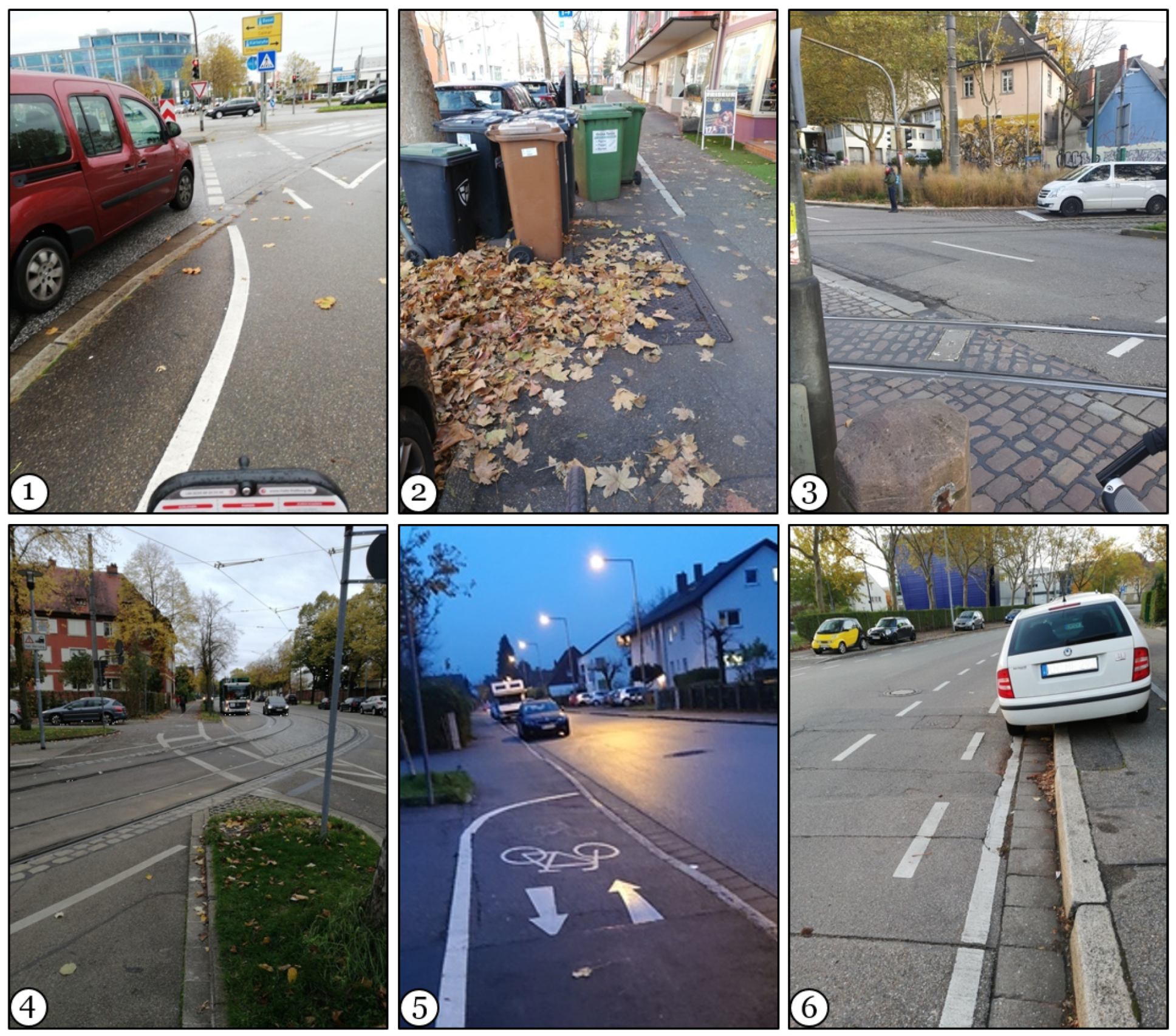
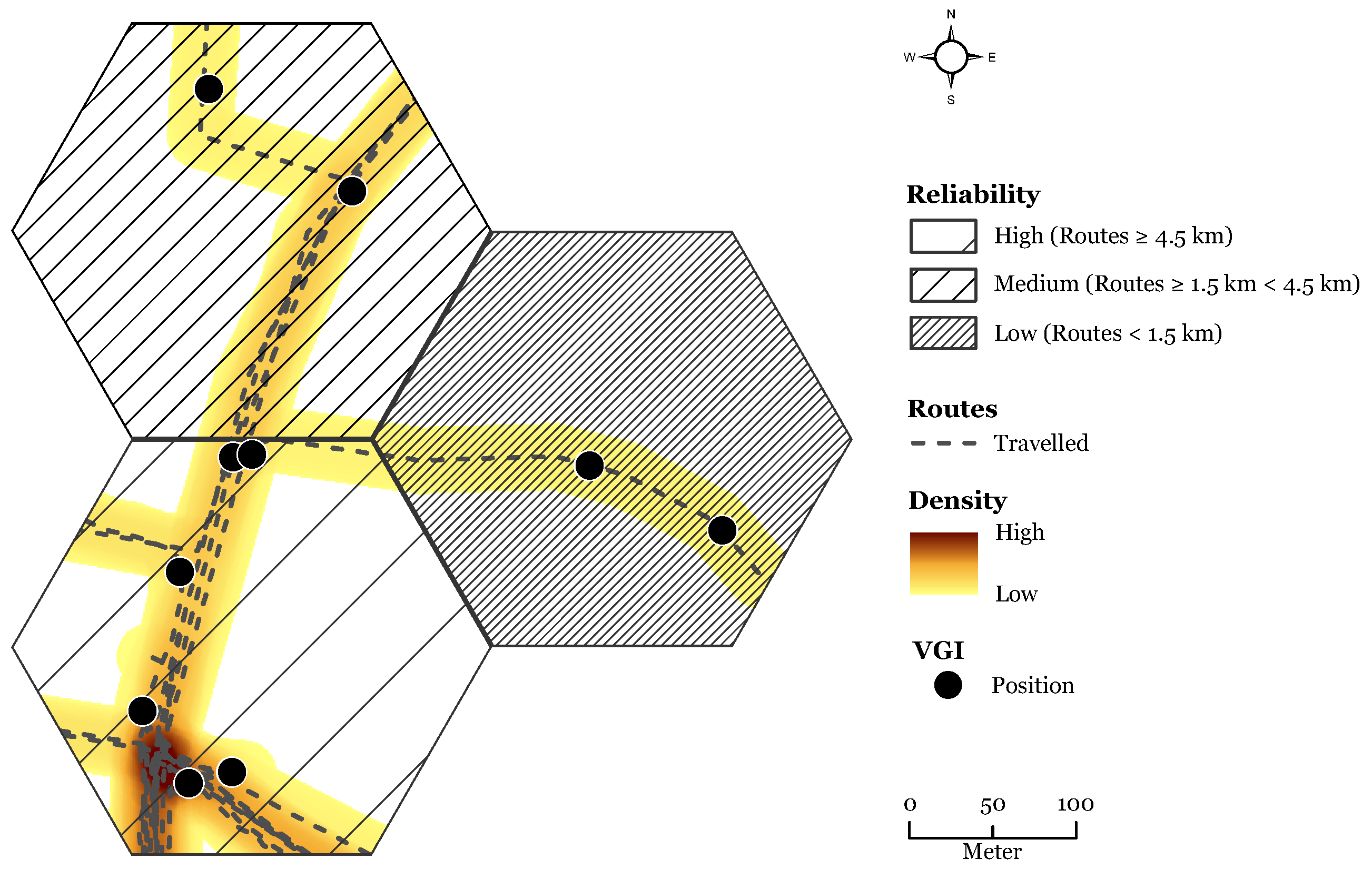
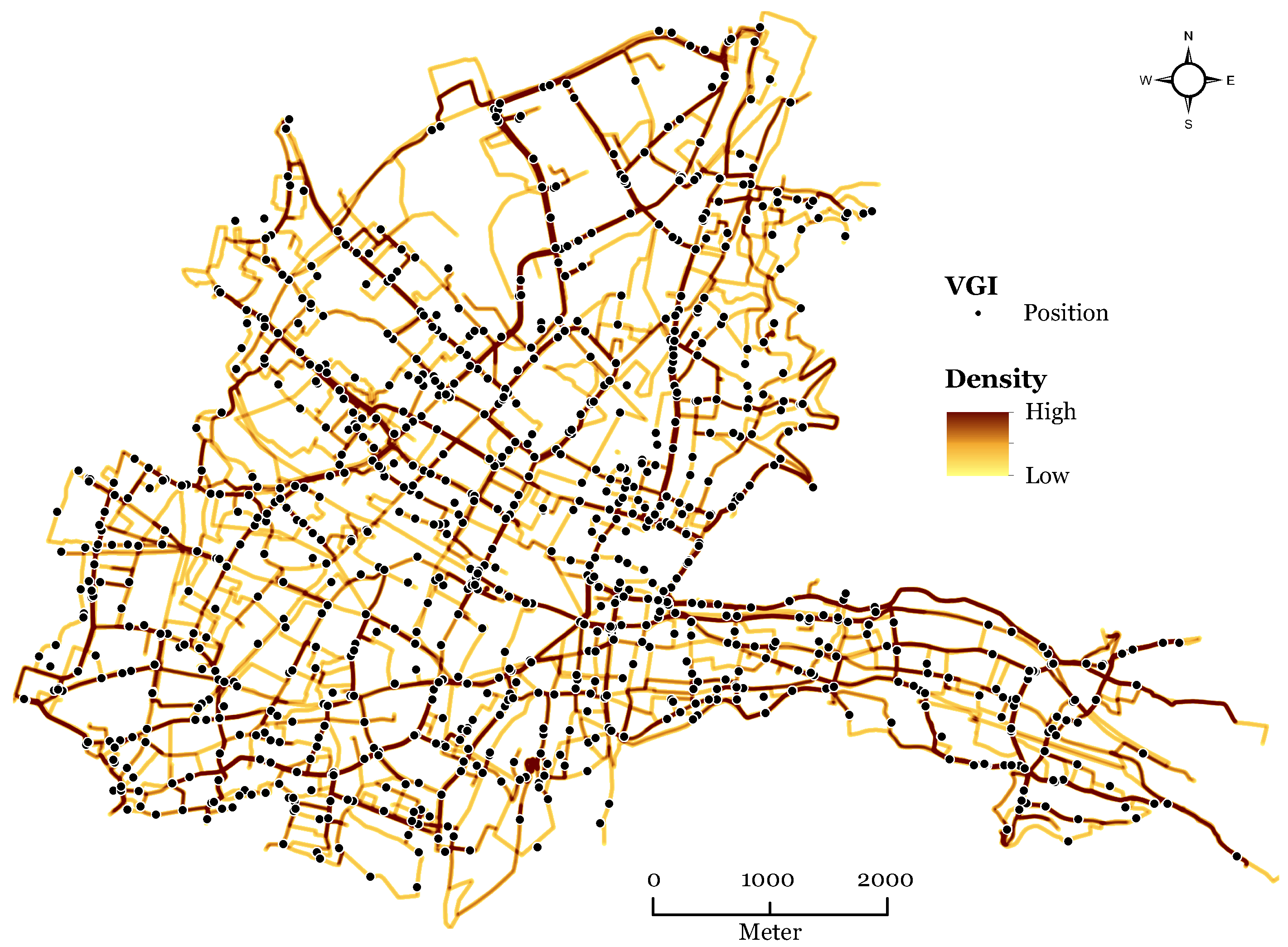
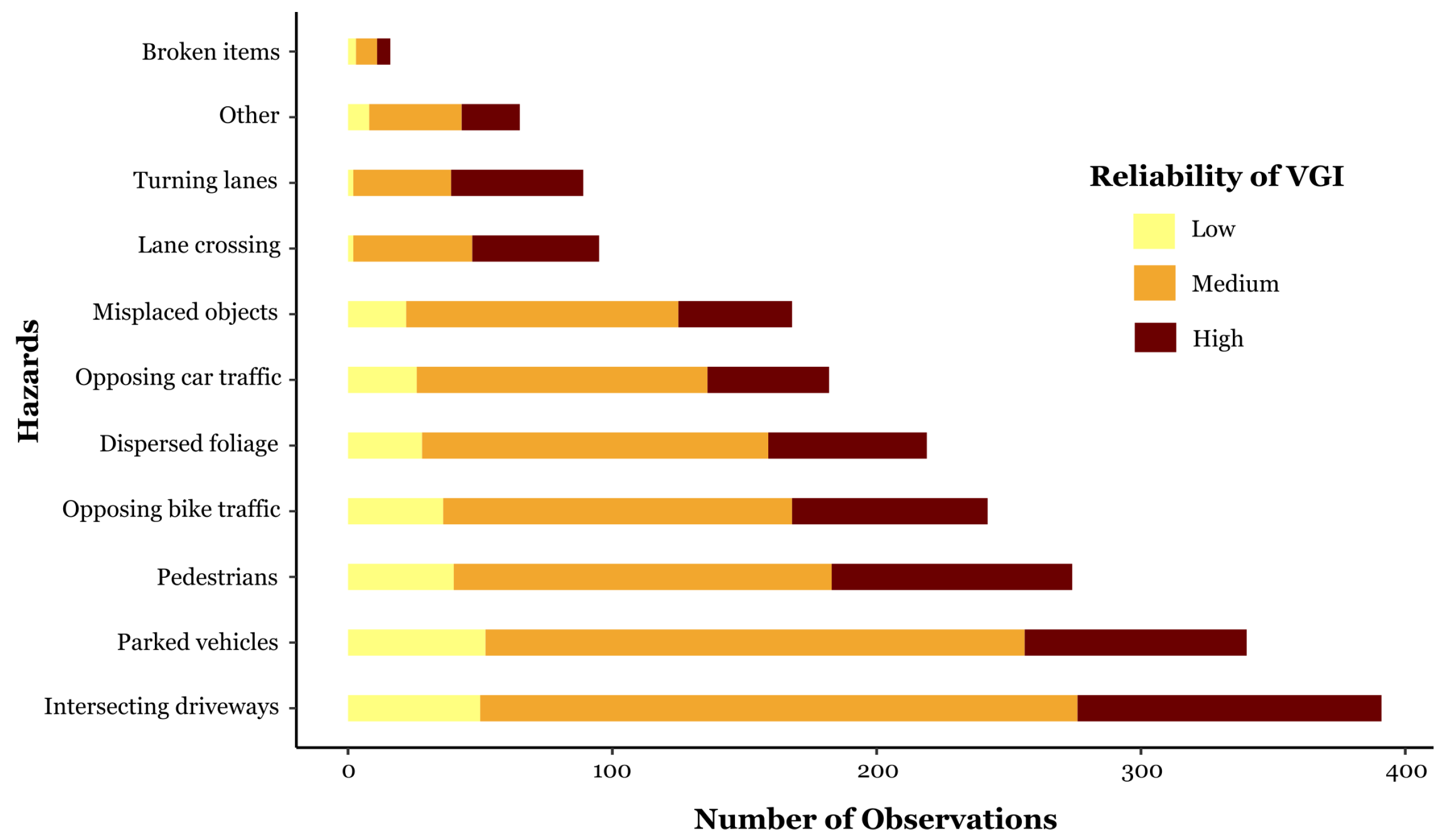

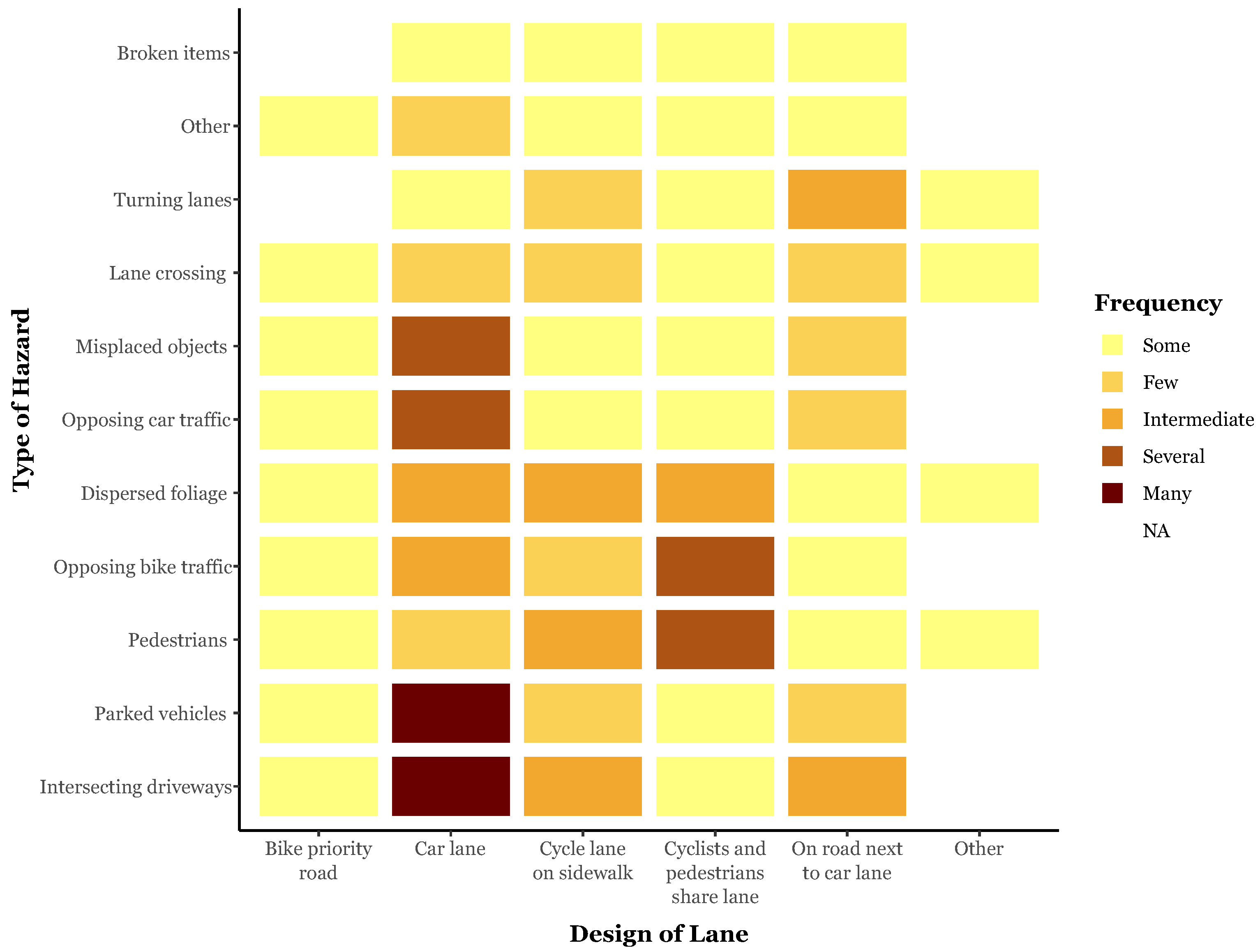
| Year | Other Accidents | Bicycle Accident | Total |
|---|---|---|---|
| 2016 | 462 | 449 | 911 |
| 2017 | 430 | 422 | 852 |
| 2018 | 430 | 470 | 900 |
© 2020 by the authors. Licensee MDPI, Basel, Switzerland. This article is an open access article distributed under the terms and conditions of the Creative Commons Attribution (CC BY) license (http://creativecommons.org/licenses/by/4.0/).
Share and Cite
Hologa, R.; Riach, N. Approaching Bike Hazards via Crowdsourcing of Volunteered Geographic Information. Sustainability 2020, 12, 7015. https://doi.org/10.3390/su12177015
Hologa R, Riach N. Approaching Bike Hazards via Crowdsourcing of Volunteered Geographic Information. Sustainability. 2020; 12(17):7015. https://doi.org/10.3390/su12177015
Chicago/Turabian StyleHologa, Rafael, and Nils Riach. 2020. "Approaching Bike Hazards via Crowdsourcing of Volunteered Geographic Information" Sustainability 12, no. 17: 7015. https://doi.org/10.3390/su12177015
APA StyleHologa, R., & Riach, N. (2020). Approaching Bike Hazards via Crowdsourcing of Volunteered Geographic Information. Sustainability, 12(17), 7015. https://doi.org/10.3390/su12177015





